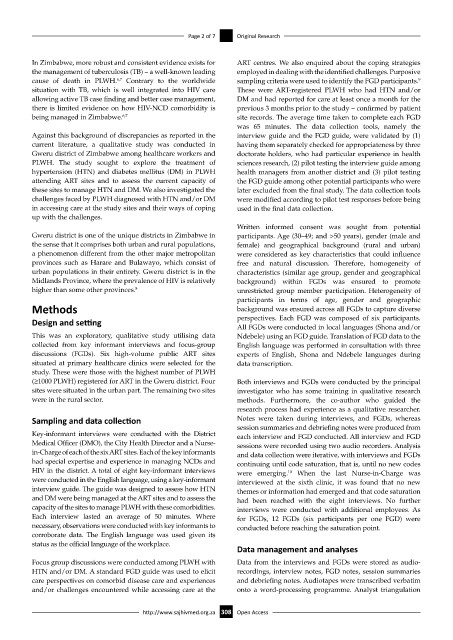Page 316 - HIVMED_v21_i1.indb
P. 316
Page 2 of 7 Original Research
In Zimbabwe, more robust and consistent evidence exists for ART centres. We also enquired about the coping strategies
the management of tuberculosis (TB) – a well-known leading employed in dealing with the identified challenges. Purposive
9
cause of death in PLWH. Contrary to the worldwide sampling criteria were used to identify the FGD participants.
6,7
situation with TB, which is well integrated into HIV care These were ART-registered PLWH who had HTN and/or
allowing active TB case finding and better case management, DM and had reported for care at least once a month for the
there is limited evidence on how HIV-NCD comorbidity is previous 3 months prior to the study – confirmed by patient
being managed in Zimbabwe. 6,7 site records. The average time taken to complete each FGD
was 65 minutes. The data collection tools, namely the
Against this background of discrepancies as reported in the interview guide and the FGD guide, were validated by (1)
current literature, a qualitative study was conducted in having them separately checked for appropriateness by three
Gweru district of Zimbabwe among healthcare workers and doctorate holders, who had particular experience in health
PLWH. The study sought to explore the treatment of sciences research, (2) pilot testing the interview guide among
hypertension (HTN) and diabetes mellitus (DM) in PLWH health managers from another district and (3) pilot testing
attending ART sites and to assess the current capacity of the FGD guide among other potential participants who were
these sites to manage HTN and DM. We also investigated the later excluded from the final study. The data collection tools
challenges faced by PLWH diagnosed with HTN and/or DM were modified according to pilot test responses before being
in accessing care at the study sites and their ways of coping used in the final data collection.
up with the challenges.
Written informed consent was sought from potential
Gweru district is one of the unique districts in Zimbabwe in participants. Age (30–49; and >50 years), gender (male and
the sense that it comprises both urban and rural populations, female) and geographical background (rural and urban)
a phenomenon different from the other major metropolitan were considered as key characteristics that could influence
provinces such as Harare and Bulawayo, which consist of free and natural discussion. Therefore, homogeneity of
urban populations in their entirety. Gweru district is in the characteristics (similar age group, gender and geographical
Midlands Province, where the prevalence of HIV is relatively background) within FGDs was ensured to promote
higher than some other provinces. 8 unrestricted group member participation. Heterogeneity of
participants in terms of age, gender and geographic
Methods background was ensured across all FGDs to capture diverse
Design and setting perspectives. Each FGD was composed of six participants.
All FGDs were conducted in local languages (Shona and/or
This was an exploratory, qualitative study utilising data Ndebele) using an FGD guide. Translation of FGD data to the
collected from key informant interviews and focus-group English language was performed in consultation with three
discussions (FGDs). Six high-volume public ART sites experts of English, Shona and Ndebele languages during
situated at primary healthcare clinics were selected for the data transcription.
study. These were those with the highest number of PLWH
(≥1000 PLWH) registered for ART in the Gweru district. Four Both interviews and FGDs were conducted by the principal
sites were situated in the urban part. The remaining two sites investigator who has some training in qualitative research
were in the rural sector. methods. Furthermore, the co-author who guided the
research process had experience as a qualitative researcher.
Sampling and data collection Notes were taken during interviews, and FGDs, whereas
session summaries and debriefing notes were produced from
Key-informant interviews were conducted with the District each interview and FGD conducted. All interview and FGD
Medical Officer (DMO), the City Health Director and a Nurse- sessions were recorded using two audio recorders. Analysis
in-Charge of each of the six ART sites. Each of the key informants and data collection were iterative, with interviews and FGDs
had special expertise and experience in managing NCDs and continuing until code saturation, that is, until no new codes
HIV in the district. A total of eight key-informant interviews were emerging. When the last Nurse-in-Charge was
10
were conducted in the English language, using a key-informant interviewed at the sixth clinic, it was found that no new
interview guide. The guide was designed to assess how HTN themes or information had emerged and that code saturation
and DM were being managed at the ART sites and to assess the had been reached with the eight interviews. No further
capacity of the sites to manage PLWH with these comorbidities. interviews were conducted with additional employees. As
Each interview lasted an average of 50 minutes. Where for FGDs, 12 FGDs (six participants per one FGD) were
necessary, observations were conducted with key informants to conducted before reaching the saturation point.
corroborate data. The English language was used given its
status as the official language of the workplace.
Data management and analyses
Focus group discussions were conducted among PLWH with Data from the interviews and FGDs were stored as audio-
HTN and/or DM. A standard FGD guide was used to elicit recordings, interview notes, FGD notes, session summaries
care perspectives on comorbid disease care and experiences and debriefing notes. Audiotapes were transcribed verbatim
and/or challenges encountered while accessing care at the onto a word-processing programme. Analyst triangulation
http://www.sajhivmed.org.za 308 Open Access

